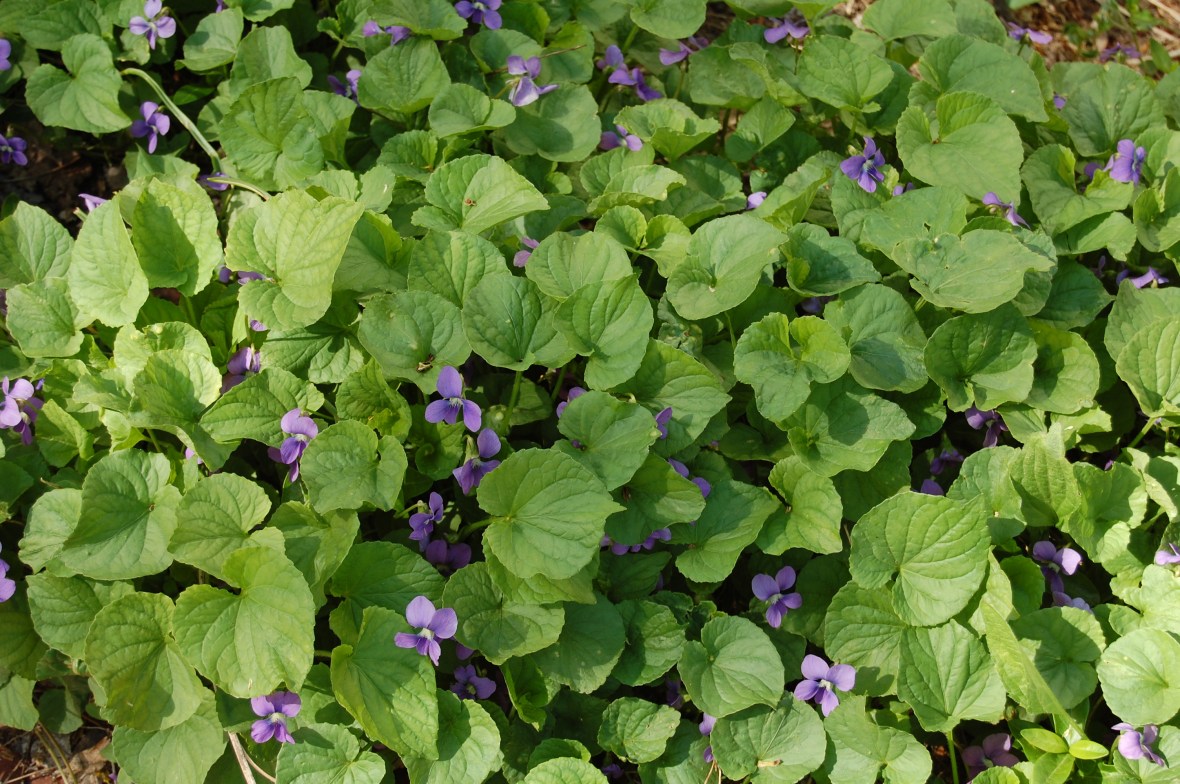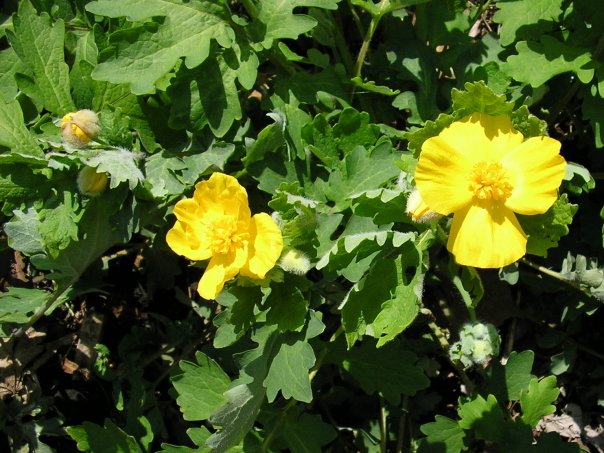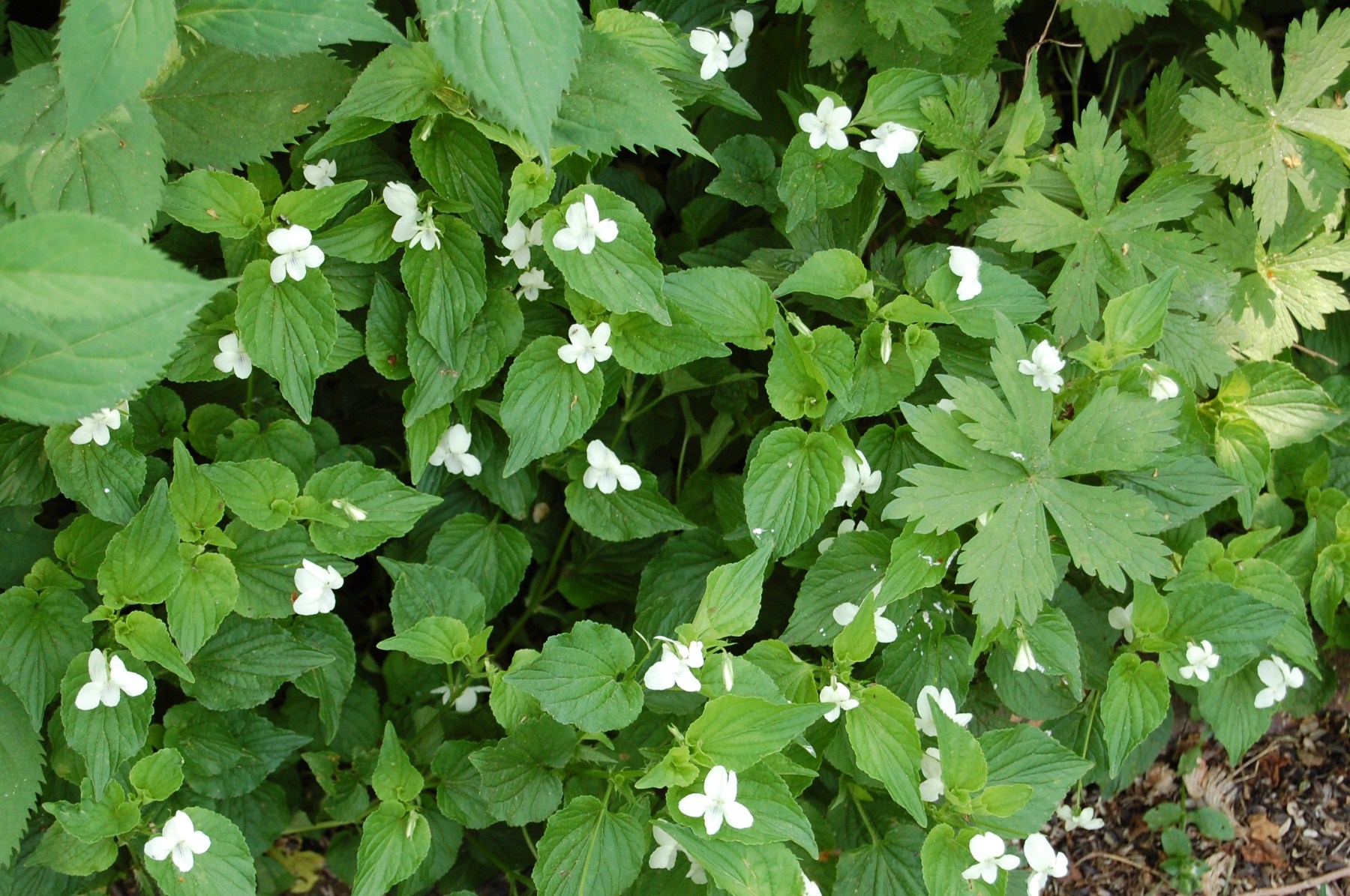I need to figure out how to make sure the ground is fully covered in the Driveway Border. This is a border with a lot of tall prairie plants, and while they abundantly fill the upper stories, as it were, of the border, there is still some open ground, especially at certain times of year.

There are some medium-height plants, but what I need is more ground-level filler plants, less than 1′ tall plants. A factor that makes this more complicated is that while this border is in almost-full sun, these shorter plants must be able to tolerate the shade thrown by all their tall neighbors.
I have some Daylilies and Nepeta, mainly along the west edge, and Celandine Poppy and (Stylophorum diphyllum) and Wild Geranium (Geranium maculatum) along the shadier east edge. But there is a need for more in the interior.

Here’s the thing. There’s also a shit ton (can I say that on a family blog?) of self-sown violets, not to mention all the self-sown Celandine Poppies. And I’ve been thinking: why not just let the Celandine Poppies and Violets go crazy and fill in every vacant niche in this border? Instead of struggling vainly to control these rampant spreaders, and trying to introduce some new plant or plants to play that role.

Arguments for this approach: it would be cheap and easy. Plus these are native plants, after all. Violets also are butterfly host plants.
Possible arguments against:
- The Celandine Poppy gets raggedy in summer.
- Most of the neighbors think that Violets are weeds, though I myself (mostly) don’t feel that way. Up until now I have welcomed Violets in the lawn and as a ground cover in the Back Garden, but have tried to control it in the sunny beds.
- Violets would look out of place with tall prairie plants. Shouldn’t the filler be something more grassy, like a Sedge? On the other hand, many of the prairie plants will also grow in savannas and woodland edges. Plus, the Illinois Wildflowers website says that Common Blue Violet (Viola sororia) grows in black soil prairies.

This question is causing a serious case of Garden Fretting. Should I cover the ground by letting these two plants run wild or should I put in something new? And if so, what?






I vote run wild… 🙂
OK, that’s one for run wild.
I agree with you, Violets are not weeds. And far more important for our insect neighbors than regular grass. I find that Geranium and violets fill in nicely, covering the soil where needed, and can easily be removed when necessary. However, I am unfamiliar with Celandine Poppy. I have used welsh poppies in difficult to grow areas that need a touch of color, and the bumble bees love them. So, I guess my vote is also run wild….
Celandine Poppy is not really a poppy, but it looks like one. I could add a few Geraniums …
I agree, let them run wild! I am letting the violets grow in my garden because of the butterflies, we don’t have your Celandine Poppy here but it looks good for the bees, looks like a win-win situation to me.
Another vote for run wild! I sense a momentum building.
How about daylilies. Hemerocallis. They look so fab and there are a huge range of colours to choose from. I love violets but they are going to look lost amongst the rest of your show stopping display
Daylilies are a thought, though they may be too substantial to weave around taller plants and fill in empty spaces. I do have some already, though, they seem happy.
There are smaller varieties such as H Little Grapette. Fun project!
My sympathies on the Garden Fretting, a serious occupational hazard. I see nothing wrong with going wild, but I think I might imagine an herb or two filling in. Thyme? Sweet Woodruff? In my experience, the rabbits don’t like either. I’d suggest salad burnet, but the rabbits do like that.
I’m afraid the Thyme would be shaded by the taller plants, but Sweet Woodruff could work.
Well, it’s a pleasant sort of dilemma to wrestle with on a cold January day. I do love violets but they have ambitions to take over the world. I let them romp in shady woodland areas. How about hardy geraniums? Some of them bloom for ages. ‘Ann Folkard’, ‘Mavis Simpson’, ‘Rozanne’ come to mind.
Yes, that’s an intriguing idea. ‘Ann Folkard’ is a stunner!
i can’t imagine a space big enough to put a plant in. 🙂 I like violets, but up north they don’t bloom that long and are just little green carpets which I guess means they’d do the job to keep the weeds out. I do like the idea of sweet woodruff better though.
Yes, Sweet Woodruff is nice plus it should tolerate the shade from taller plants.
I vote for let ‘um go wild! But the hardy geraniums are an interesting idea, too. In my garden sweet woodruff starts looking crappy mid summer. Go to some of your fave nursery websites and check out ground covers? I’m sure whatever you decide to do will be lovely!
Are the sweet woodruff in full sun?
Nope, pretty close to full shade.
Plant some other wildflowers, too, like, Spring beauties, Salvia lyrata, Fragaria virginica (Wild Strawberry), Senecio plattensis (Prairie Ragwort) Antennaria spp. (Pussytoes).
All good ideas. Maybe Golden Groundsel – is that the same as Prairie Ragwort?
Sounds like the cold weather is getting to you. Last night I thought I should ditch the vegetable garden and was picking out dahlias to fill it with, today I’m looking at magnolias and thinking the whole yard should just be a shade garden. Last weekend I almost ordered more chrysanthemums than my garden could have ever held. It happens.
I vote hardy geraniums or spring bulbs. I’m not a fan of violets or celandine poppy, both seem weedy to me natives or not.
Hardy Geranium is not a bad idea.
I would do it. It’s funny you are mentioning this, because I’ve come to the same decision for my beds. Like you I want “shoes” covering up the bare spots, and suddenly I realized I had been pulling up the very plants that wanted to help. I don’t think violets look weedy at all and it is a chance to open people’s eyes.
You could also try ginger. I have it in my front garden and it has galloped through all the gaps. Or how about Anemone canadensis? It is a spreader and very lovely. Gets a bit taller, though, now that I think of it.
I do have lots of ginger in the back garden and other shady areas. It’s a good suggestion, as is the Anemone canadensis – though I’m not sure the soil in this border is moist enough.
The wild strawberry is a great idea. I have that, too, and it functions well as a ground cover, feeds native bees, and you get yummy berries out of the deal!
I have Wild Strawberry, but I don’t find that it covers the ground thickly enough to suppress weeds.
Letting the violets run is probably the best idea.
I say try working with these two for a couple of years to see if they do what you want them to do- they are obviously already happy there so they might just be the best solution (right plants, right place!). You can always dig them out and plant those sedges if you aren’t happy with them. I’ll also throw in California poppies- they thrive in similar conditions in my yard and self-seed happily and I grew all mine from one packet of seeds scattered on bare earth.
That’s a sensible approach. I’ve tried just throwing around some CA poppy seeds but ther seems to be too much shade from the taller plants.
I know that violets will stay green and look pretty good through out summer. They have their major bloom in early spring a put other blooms out after drought and a few others now and then. I know nothing about the poppies but I agree with those that say go with what is working if you aren’t sure about the sedge. Heck violets will go anyplace there is a spare inch.
The violets do stay nice and green throughout the summer.
I am pro-violet. Another crazy idea might be grape hyacinth? They bloom in the spring, then reseed themselves and look like grass the rest of the summer. Or chives? The shade might keep them from getting to wild and crazy.
Chives are a good idea – maybe garlic chives. They certainly to spread!
I’d go with the violets.
Thanks for adding your voice – violets are getting a lot of supports!
They’re pretty and sometimes it’s easier to flow with the current than to fight it.
What do I know? But you might take a look at the Carolina geranium if you haven’t. We have it here, and it spreads along the ditches easily and beautifully. It’s native, has attractive flowers, attracts pollinators, and in the autumn its foliage is very pretty. It tops out at about 1′, too, which would meet your height requirements.
There’s nothing wrong with violets, either. Violets are not a weed in my book. Letting them run wild wouldn’t bother me one bit.
Another possibility, and it’s hardy in my zone despite the name.
I think I would stick with the violets. If something grows well and doesn‘t upset other plants I let it spread. 🙂
Hard to argue with that.
I have violets in the garden but need to keep on top of them so they don’t take over. Maybe violets in front, with some hyssop (Hyssopus officinalis ssp. aristadus) behind them. Hyssop is hardy, can be pruned back when necessary, and attracts pollinators. It only gets 1’ or so tall.
I have never grown Hyssop. I do have Anise Hyssop, Agastache foeniculum, but that is something entirely different, I guess. Maybe I should give Hyssop a try.
Maybe let them run wild for a year and add a few additional plants. You can always tame them the following year.xxx
I may end up doing just that.
Yes! You knew of course I would say yes – lol. I have had the same debate with violets and am trying a “bed” of violets with edging to see if en masse it looks a bit more planned rather than random. Will keep you posted. I also understand that native violets are host plants for certain early spring butterfly larva.
Seems like Violets are the people’s choice.
Another vote for violets here. I am particularly fond of Viola labradorica and will be planting some on purpose later this year, with the hopeful admonition to “be fruitful and multiply!” LOL
V. labrodorica doesn’t seem to spread much in our garden. I planted some and it faded away. But your garden may be better suited for it.
You’re asking this on a blog? What I would recommend for here probably would not be practical there. Actually, I can think of a few species that would not be practical. I don’t like the idea of letting something run wild, even though I do a lot of it, just because if they run wild, they are likely to get too wild invasive, such as violets. I happen to like violets of all kinds, so would ten to let them stay in a large but contained area, but probably not cover big area. I keep saying that about fleabane, but it ends up getting everywhere.
I also resist the idea of letting something go wild, but then in certain instances it could be the right thing to do.
like freeway iceplant on the cliff at the beach! That stuff is rad!
a good groundcover for a mixed area would be:
ajuga
biokovo geranium
a non-vining bush clematis (an under-used filler solution)